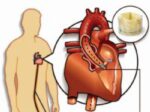Original title: Emerging indications, in-hospital and long-term outcome of balloon aortic valvuloplasty in the transcatheter aortic valve implantation era. Reference: Francesco Saia et al. EuroIntervention 2013;8:1388-1397 Until a few years ago, aortic valvuloplasty had been abandoned by many centers due to its limited results and frequent complications. The current guidelines recommend aortic valvuloplasty to treat patients with symptomatic<a href="https://solaci.org/en/2013/05/21/aortic-valvuloplasty-in-the-transcatheter-aortic-valve-implantation-era/" title="Read more" >...</a>
Valve-in-Valve Implantation Is Possible
Original title: 5 Years Experience With Trancatheter Tranaspical Mitral Valve –in Valve Implantation for Bioprosthetic Valve Dysfunction Reference: Anson Cheung et al. J Am Coll Cardiol 2013;61:1759–66. Percutaneous valves development, first aortic and now mitral, has brought an opportunity to improve life quality and extend life for high risk non-surgical patients. 23 patients received transapical implantation in mitral<a href="https://solaci.org/en/2013/04/29/valve-in-valve-implantation-is-possible/" title="Read more" >...</a>
CoreValve versus Edwards. Equivalent results at one year
Original title: Transcatheter Aortic Valve Implantation With the Edwards SAPIEN Versus the Medtronic CoreValve Revalving System Devices. A Multicenter Collaborative Study: The PRAGMATIC Plus Initiative (Pooled-RotterdAm-Milano-Toulouse In Collaboration). Reference: Alaide Chieffo et al. J Am Coll Cardiol 2013;61:830–6. Since the introduction of percutaneous aortic valve replacement (TAVR), two devices have been widely used. For one side, the self-expanding<a href="https://solaci.org/en/2013/03/10/corevalve-versus-edwards-equivalent-results-at-one-year/" title="Read more" >...</a>
Transfemoral Transcatheter Aortic Valve Implantation: more experience and better results.
Original title: Trends in outcome after transfemoral transcatheter aortic valve implantation. Pooled-RotterdAm-Milano-Toulouse In Collaboration Plus (PRAGMATICPlus) initiative. Reference: Nicolas M. Van Mieghem et al. Am Heart J 2012;0:1-10. Article in press. Since its introduction in 2002, Transfemoral Transcatheter Aortic Valve Implantation (TAVI) has turned into a viable and safe strategy to treat patients with severe acute stenosis and<a href="https://solaci.org/en/2013/01/15/transfemoral-transcatheter-aortic-valve-implantation-more-experience-and-better-results/" title="Read more" >...</a>
The largest published series of valve-in-valve with Core Valve, (Medtronic).
Original title: Valve-in-Valve Implantation of Medtronic CoreValve Prosthesis in Patients with Failing Bioprosthetic Aortic Valves. Reference: Axel Linke el al. Circ Cardiovasc Interv. 2012;5:689-697. This study evaluates the safety, feasibility and results of Core Valve implants on patients with bioprostheses dysfunctional by stenosis, insufficiency or a combination of both. Biological prostheses are preferred over mechanical ones for patients<a href="https://solaci.org/en/2012/11/02/the-largest-published-series-of-valve-in-valve-with-core-valve-medtronic/" title="Read more" >...</a>
The impact of permanent pacemaker implantation in patients undergoing percutaneous aortic valve replacement.
Reference: Buellesfeld y colaboradores (JACC in press). Percutaneous aortic valve replacement (AVR) is an innovative technique for the treatment of severe aortic stenosis (SAS); this technique has been incorporated with great enthusiasm in clinical practice, particularly for patients with excessive surgical risks. Due to the proximity of the aortic valve, AV node and His bundle, there<a href="https://solaci.org/en/2012/10/01/the-impact-of-permanent-pacemaker-implantation-in-patients-undergoing-percutaneous-aortic-valve-replacement/" title="Read more" >...</a>
Aortic Transfemoral Valve Replacement using Edwards SAPIEN and Edwards SAPIEN XT Prosthesis, Local Anesthesia.
Reference: Durand E. et al (JACC CV interventions 2012 in press)1 When percutaneous aortic valve replacement (AVR) first began the procedure required a large-bore sheath (22-24 F), being the most frequent surgical strategy when using general anesthesia. Continuous technological advances achieved the miniaturization of devices which allow the procedure to be performed with a much<a href="https://solaci.org/en/2012/10/01/aortic-transfemoral-valve-replacement-using-edwards-sapien-and-edwards-sapien-xt-prosthesis-local-anesthesia/" title="Read more" >...</a>
National and Internacional Live Cases at the Next SOLACI-CACI 2024
Discover all the live national and international cases at the upcoming SOLACI-CACI 2024 Congress.
Myocardial Damage in MAC
Mitral annulus calcification (MAC) affects between 8% and 23% of the population. It is more common in women and patients with renal insufficiency. This phenomenon is characterized by an increase in valvular annulus fibrosis, which can extend and affect the leaflets. The presence of MAC is associated with valve regurgitation or stenosis, increasing mortality and<a href="https://solaci.org/en/2024/07/18/myocardial-damage-in-mac/" title="Read more" >...</a>
Edge-to-Edge Repair for Right Ventricular Function Deterioration
Tricuspid regurgitation (TR) has been associated with worse survival and hospitalization for cardiac failure (CF). The current guidelines recommend surgery as treatment, despite its 8 – 15% 30-day mortality rate. And there is no mention of a transcatheter intervention, especially for patients with severe TR and right ventricular deterioration. Several percutaneous intervention devices have recently<a href="https://solaci.org/en/2024/07/12/edge-to-edge-repair-for-right-ventricular-function-deterioration/" title="Read more" >...</a>







